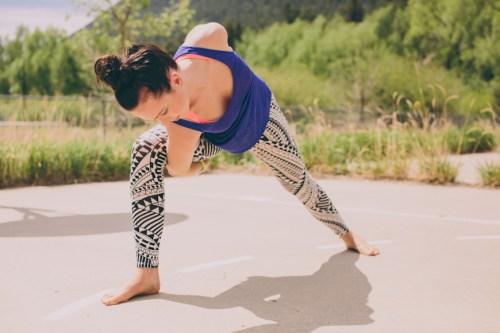The best way to open up your body in yoga (and combat rounded shoulders)? Get into a bind
According to yoga instructors, certain yoga bind poses are the best way to combat rounded shoulders and really open up your chest. Here's how to do them.

If you’ve practiced yoga before, you already know how effective it is at opening up and stretching out your entire body from head to toe. But there’s an upgrade you can give certain moves that will open you up even more, and that my friends is called a bind. (No, actually.)
A yoga bind pose involves taking one hand over one part of your body, and holding it with your other hand that is wrapped around the other side of your body. Examples would be interlacing your hands behind your knee in a twist. “There are a lot of different binds you can do, but they all do the same thing,” says Beth Cooke, a New York City-based yoga instructor. “Essentially, you’re strengthening the structure of the shape so that your muscles can relax and you can deepen into the posture.”
Imagine being in an extended side angle. Turning it into an extended side angle with a bind means that your top arm comes behind your back towards the opposite hip, and your bottom arm reaches down in front of the bent knee, with that hand coming behind the other side of your leg to grasp your other hand. It’s challenging, but gets your muscles lengthened more than they would in the traditional, unbound pose.
“Binds basically close the loop—you’re making contact, and completing the energy chain with your own body,” says Kyle Miller, yogi and co-founder of Love Yoga in Los Angeles. “Although they are very challenging, they’re very nourishing and empowering, because you’re so pulled into yourself and locked into a bind that it makes you feel safe.”
“The shoulder opening that you get from binding is unlike anything else.” —Kyle Miller, yoga instructor
The best thing about binds? They’re the perfect remedy for hunched over, rounded shoulders. “The shoulder opening that you get from binding is unlike anything else,” says Miller. “The way that binds pull that top shoulder back and really opens it up and externally rotates it can’t be matched.” Cooke adds that because binding opens up your chest towards the sky, you’re really “elongating the spine and rolling your shoulders back,” which is particularly helpful if you’re working on a computer all day long.
Even though binds are somewhat advanced, you can get similar effects by using a strap as a modification tool. “If your limbs aren’t connecting, you can take a strap in one hand and try to lengthen it out to the other and grab hold,” says Cooke. “It acts as an extension of the limb.” However you get into the position, note that it’s really important to warm your muscles (and shoulders) up before doing so, and to make sure you’re in proper alignment. “If the rest of your body is falling out of alignment just so that you can get your fingertips together, that misses the point—you don’t want to close the ribcage,” says Miller, who recommends skipping it if this is happening.
If you’re ready to try it for yourself, keep scrolling for yoga poses you can work binds into.
Yoga bind exercises
1. Bound side angle: With your lower body set up into warrior II position, and your front knee directly over front ankle, place your opposite shoulder on the inside of the front thigh. Take your top arm and reach it behind you to your lower back, then take your inside arm beneath your hamstring to clasp your fingers of the opposite hand. Keep your chest open and lifted and gaze up at the ceiling.
2. Bound malasana squat: From malasana squat, you can bind by taking your top arm and reaching it behind to grab your inner thigh (you can just do this as a half bind), then for the full bind, take the bottom arm to wrap around that knee.
3. Bound triangle: From triangle pose, move your top arm back behind you and place it on the bottom hip. Take your bottom hand underneath the front thigh and connect to your other hand.
4. Seated spinal twist with a bind: Draw one knee towards your chest from a seated position, and draw your opposite elbow to the other side of the knee, twisting your chest around to the back. Take your back arm underneath your front knee, and try to grab your hand around your back from the other side.
BTW, here’s how to do a headstand progression if you’re trying to get into inversions. And this is how the cat-cow stretch works every muscle in your body.
Sign Up for Our Daily Newsletter
Get all the latest in wellness, trends, food, fitness, beauty, and more delivered right to your inbox.
Got it, you've been added to our email list.










